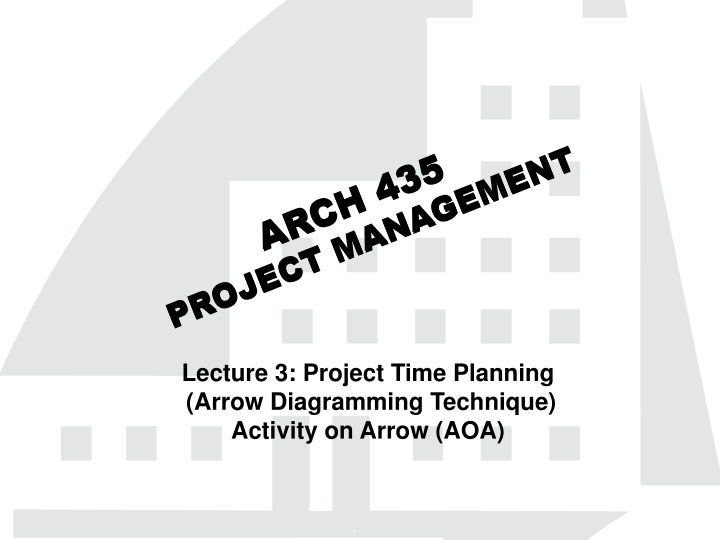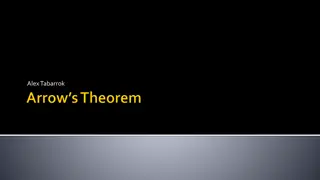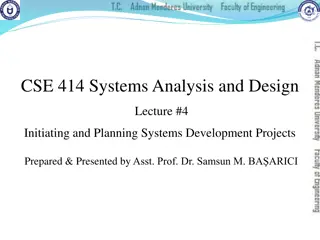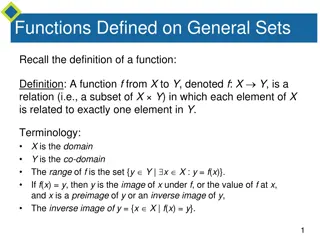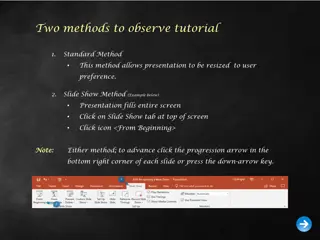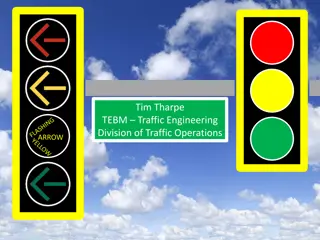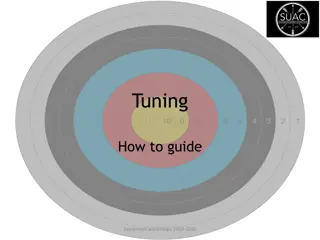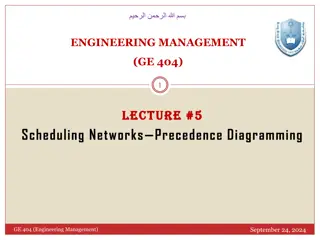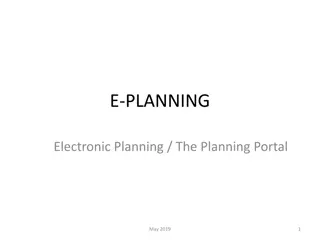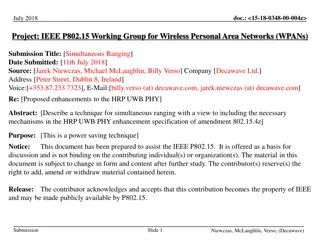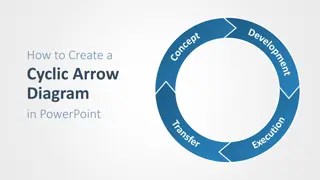Project Time Planning with Arrow Diagramming Technique
This content explores the Arrow Diagramming Technique in project time planning. It covers aspects like activity representation through arrows, event identification, making arrow diagrams, and logical relationships. The use of nodes, events, and durations are key to understanding the flow of activities in a project schedule.
Download Presentation

Please find below an Image/Link to download the presentation.
The content on the website is provided AS IS for your information and personal use only. It may not be sold, licensed, or shared on other websites without obtaining consent from the author.If you encounter any issues during the download, it is possible that the publisher has removed the file from their server.
You are allowed to download the files provided on this website for personal or commercial use, subject to the condition that they are used lawfully. All files are the property of their respective owners.
The content on the website is provided AS IS for your information and personal use only. It may not be sold, licensed, or shared on other websites without obtaining consent from the author.
E N D
Presentation Transcript
Lecture 3: Project Time Planning (Arrow Diagramming Technique) Activity on Arrow (AOA) Lecture 3: Project Time Planning (Arrow Diagramming Technique) Activity on Arrow (AOA) 1
ARROW DIAGRAM ARROW DIAGRAM 1. Each activity (task) is portrayed or presented by an arrow arrow. . Activity Site Preparation ]Duration] ]30] 2. The tail and head of the arrow denote the start and finish of the activity whilst its duration is shown in brackets below. 3. The length of the arrow has no significance neither has its orientation.
ARROW DIAGRAM ARROW DIAGRAM 4)As means of further defining the point in time, when an activity starts or finishes, start and finish events are added. 5)An event event (= node node = connector connector), unlike an activity, does not consume time or resources, it merely represents a point point in in time time at which something happens. 6)Numbers are given to the events to provide a unique identity to each activity. 7)The first event in a project schedule is the start of the project. The last event in a project schedule is the end of the project.
Activity Identification Activity Identification Start Event Finish Event Activity 10 10 20 20 [Duration] Activity identification numbers called event numbers
i i- -j Numbers of Events j Numbers of Events j i Activity Duration The node at the tail of an arrow is the i i-node. The node at the head of an arrow is the j j-node.
Rules of Making Arrow Diagram Rules of Making Arrow Diagram 1) The network (the graphical representation of a project plan) must have definite definite points points of of beginning beginning and and finish finish. (The accuracy and usefulness of a network is dependent mainly upon intimate knowledge of the project itself, and upon the general qualities of judgment and skill of the planning personnel.) 2) The arrows originate at the right right side side of a node and terminate at the left left side side of a node. 3) Any two events may be directly connected by no no more than one one activity activity. 4) Use symbols to indicate crossovers to avoid misunderstanding.
Logical Relationships Logical Relationships A B 10 10 20 20 30 30 Node 20 is the j-node for activity A and it is also the i-no de for activity B . Therefore, activity A is a predecessor to activity B . In other words activity B is a successor to activity A . Activity B depends on activity A.
Logical Relationships Logical Relationships Succeeding activities 30 30 10 10 20 20 40 40 50 50 Event numbers must not be duplicated in a network. j-node number is always greater than i-node number.
Logical Relationships Logical Relationships Concurrent activities (happens at the same time) 80 80 180 180 120 120 170 170 190 190 160 160
Rules of Making Arrow Diagram Rules of Making Arrow Diagram 5) The network must be a logical representation of all the activities. Dummy Activities are used, where necessary for: Unique numbering, and Logical sequencing. Dummy Dummy activity a dependency of one activity upon another. A dummy activity has a zero zero time. It is also called dependency arrow arrow. activity is an arrow that represents merely dependency
Dummy Activities Dummy Activities The following network shows incorrect activity numbering. 90 90 A 50 50 70 70 80 80 100 100 B 110 110 60 60
Dummy Activities Dummy Activities For unique numbering, use a dummy activity. 75 75 90 90 50 50 70 70 80 80 100 100 110 110 60 60
Dummy Activities Dummy Activities For representing logical relationships, you may need dummy activities. 10 50 30 40 20 In this diagram: Activity C depends on Activities A, B. Activity D depends on Activities A, B. LETS SAY, Activity C depends on Activity A ONLY, and Activity D depends on Activities A, B. How can we represent this relationship?
Dummy Activities Dummy Activities In this case, use a dummy activity to indicate the correct relationship. C A 50 10 30 B D 35 40 20 Now, Activity C depends on Activities A ONLY. Activity D depends on Activities A, B.
Rules of Making Arrow Diagram Rules of Making Arrow Diagram 6) There must be no "looping" in the network. The loop is an indication of faulty logic. The definition of one or more of the dependency relationships is not valid. 90 100 120 130 110
Rules of Making Arrow Diagram Rules of Making Arrow Diagram 7) The network must be continuous (without unconnected activities). 30 60 100 10 20 50 90 120 40 70 110 80
Rules of Making Arrow Diagram Rules of Making Arrow Diagram 8) Networks should have only one initial event and only one terminal event. 30 60 10 20 50 90 120 40 70 110
Rules of Making Arrow Diagram Rules of Making Arrow Diagram 9) Before an activity may begin, all activities preceding it must be completed between activities is (finish finish to (the to start start). logical relationship
Network Analysis (Computation) Network Analysis (Computation) 1. 1. Occurrence Occurrence times of of event event occurrence times of occurrence = = Early of Events Events = = Early Early and Early and and late late event and late event times late timings timings times Earliest Event Time Activity Activity Event Label Latest Event Tail Head Time Standard layout for recording data
Early Event Time (EET = E =T Early Event Time (EET = E =TE E) ) Early Early Event at which an event can occur, considering the duration of precedent activities. Event Time Time (Earliest (Earliest occurrence occurrence time time for for event) event) is the earliest time Forward Forward Pass Each activity starts as soon as possible, i.e., as soon as all of its predecessor activities are completed. 1. 1. Direction Direction: : Left Left to to right, right, from from the the beginning beginning to 2. 2. Set Set: : EET EET of of the the initial initial node node = = 0 0 3. 3. Add Add: : EET EETj j= = EET EETi i+ + D Dij ij 4. 4. Take Take the the maximum maximum The The estimated estimated project project duration duration = = EET Pass for for Computing Computing EET EET to the the end end of of the the project project EET of of the the last last node node. . Activity EETj EETi i j j Dij
Early Event Times (EET = E =T Early Event Times (EET = E =TE E) ) A B C 0 0 3 3 4 4 12 12 40 40 10 10 20 20 30 30 1 1 8 8 3 3
Early Event Times (T Early Event Times (TE E) ) 4 4 40 40 15 15 L L 24 24 70 70 80 80 9 9 12 12 50 50
Early Event Times (T Early Event Times (TE E) Example: ) Example: 20 20 50 50 3 3 2 2 3 3 30 30 70 70 1 10 0 4 4 7 7 60 60 3 3 40 40
Early Event Times (T Early Event Times (TE E) ) 2 2 8 8 20 20 50 50 3 3 2 2 3 3 4 4 0 0 16 16 30 30 70 70 1 10 0 4 4 7 7 9 9 60 60 3 3 3 3 40 40
Late Event Time (LET = L =T Late Event Time (LET = L =TL L) ) Late Late Event Event Time e at which an event can occur, if the project is to be completed on schedule. Time (Latest (Latest occurrence occurrence time time of of event) event) is the latest tim Backward Backward Pass Pass for for Computing Computing LET LET 1. 1. 2. 2. 3. 3. Subtract Subtract: : LET 4. 4. Take Take the the minimum Direction Direction: : Right Set Set: : LET LET of Right to of the the last LETi i= = LET minimum to left, left, from last (terminal) (terminal) node LETj j- - D Dij ij from the the end node = = EET end to to the the beginning beginning of EET . . of the the project project Activity EET EETi i EETj EETj i j j LETi LETj Dij
Late Event Times (T Late Event Times (TL L) ) 8 50 13 3 16 60 9 16 7 40 9
Late Event Times (T Late Event Times (TL L), Example: ), Example: 2 8 50 20 3 3 4 0 16 30 70 10 4 9 7 60 3 40
Late Event Times (T Late Event Times (TL L), Example: ), Example: 2 8 20 50 10 3 13 3 4 0 16 30 70 10 16 0 4 4 9 7 60 9 3 40 8
Network Analysis (Computation) Network Analysis (Computation) 2. 2. Activity Activity Times Times (Schedule) (Schedule) 1. 1. Early Early Start be started. Start (ES) (ES): The earliest time at which an activity can ES ESij ij= EET = EETi i 2. 2. Early Early Finish be completed. Finish (EF) (EF): The earliest time at which an activity can EFij = ESij + Dij EFij = ESij + Dij 3. 3. Late Late Finish Finish (LF) e completed without delaying project completion. LFij = LETj LFij = LETj (LF): The latest time at which an activity can b 4. 4. Late Late Start started. Start (LS) (LS): The latest time at which an activity can be LSij = LFij LSij = LFij Dij Dij
Example: Activity Times Example: Activity Times 2 8 20 50 10 3 13 4 0 16 30 70 10 16 0 4 4 9 60 3 9 3 40 8 ES20-50= EET20= 2 EF20-50= ES + D = 2 + 3 = 5 LF20-50= LET50= 13 LS20-50= LF D = 13 3 = 10
Network Analysis (Computation) Network Analysis (Computation) Activity Activity Floats Floats 1. 1. Total Total Float Float (TF) (TF) Total Total float an activity s completion may be delayed without extending extending project project completion completion time float or or path path float float is the amount of time that without time. Total Total floa n activity s completion may be delayed without ecting ecting the the earliest earliest start start of rk rk critical critical path path. . float or or path path float float is the amount of time that a without aff on the the netwo aff of any any activity activity on netwo
Network Analysis (Computation) Network Analysis (Computation) Activity Activity Floats Floats 1. 1. Total Total Float Float (TF) (TF) Total path float time for activity (i-j) is the total float associated with a path. For arbitrary activity (i j), the total float can be written as: Path Path Float Float = =Total Total Float Float (TF = = LS = = LF = = LET (TFij ij) ) LSij ij ES LFij ij EF LETj j EET ESij ij EFij ij EETi i D Dij ij
Example: Total Float Times Example: Total Float Times 2 8 20 50 10 3 13 3 2 4 4 0 16 30 70 10 16 0 4 4 5 9 7 60 3 TF20-50= LS20-50- ES20-50 TF20-50= 10 2 = 8 TF20-50= LF20-50- EF20-50 TF20-50= 13 5 = 8 TF20-50= LET50 EET20- D20-50 TF20-50= 13 2 3 = 8 9 3 40 1 8
Network Analysis (Computation) Network Analysis (Computation) Activity Activity Floats Floats 2. 2. Free Free Float Float (FF) (FF) Free float or activity float is the amount of time that an activity s completion time may be delayed without the the earliest earliest start start of of succeeding succeeding activity without affecting affecting activity. Activity float is owned by an individual activity, whereas path or total float is shared by all activities along a slack path. Total Total float float always always equals equals or or exceeds exceeds free free float float (TF (TF FF) FF). For arbitrary activity (i j), the free float can be written as: Activity Activity Float Float = = Free Free Float Float (FF = = ES ESjk jk EF = = EET EETj j EET (FFij ij) ) EFij ij EETi i D Dij ij
Example: Free Float Times Example: Free Float Times 2 8 20 50 10 3 13 3 2 4 4 0 16 30 70 10 16 0 4 4 5 9 7 60 3 9 3 40 1 8 FF20-50= ES50-70 EF20-50 FF20-50= 8 5 = 3 FF20-50= EET50 EET20- D20-50 FF20-50= 8 2 3 = 3
Network Analysis (Computation) Network Analysis (Computation) 3. 3. Activity Activity Floats Floats Interfering Interfering Float Float (ITF) (ITF) Interfering float is the difference between TF and FF. If ITF of an activity is used, the start of some succeeding activities will be delayed beyond its ES. In other words, if the activity uses its ITF, it interferes by this amount with the early times for the down path activity. For arbitrary activity (i j), the Interfering float can be writte n as: Interfering Interfering Float Float ( (ITF ITFij ij) ) = = TF = = LET TFij ij FF LETj j EET FFij ij EETj j
Example: Interfering Float Times Example: Interfering Float Times 2 8 20 50 10 3 13 3 2 4 4 0 16 30 70 10 16 0 4 4 5 9 7 60 3 9 3 ITF20-50= TF20-50- FF20-50 IFF20-50= 8 3 = 5 ITF20-50= LET50 EET50 ITF20-50= 13 8 = 5 1 40 8
Network Analysis (Computation) Network Analysis (Computation) 3. 3. Activity Activity Floats Floats Independent Independent Float Float (IDF) (IDF) It is the amount of float which an activity will always posse ss no matter how early or late it or its predecessors and s uccessors are. The activity has this float independent of any slippage o f predecessors and any allowable start time of successors . Assuming Assuming all all predecessors predecessors end end as ccessors ccessors start start as as early early as as possible possible. as late late as as possible possible and and su su IDF is owned by one activity. In all cases, independent float is always less than or equal to free float (IDF IDF FF FF).
Network Analysis (Computation) Network Analysis (Computation) 3. 3. Activity Activity Floats Floats Independent Independent Float Float (IDF) (IDF) For arbitrary activity (i j), the Independent Float can be wri tten as: Independent Independent Float Float ( (IDF IDFij ij) ) = = Max Max ( (0 0, , EET EETj j LET = = Max Max ( (0 0, , Min Min ( (ES LETi i D Dij ij) ) ESjk jk) ) - - Max LFli li) ) D Dij ij) ) Max ( (LF
Example: Independent Float Times Example: Independent Float Times 2 8 20 50 10 3 13 3 2 4 4 0 16 30 70 10 16 0 4 4 5 9 7 60 3 9 3 1 40 8 IDF20-50= Max. (0, [EET50 LET20- D20-50]) IDF20-50= Max. (0, [8 10 3]) = 0
